Letter from the Algarve: December
It is the
end of november. The main activity of everyone I know seems to be to
avoid as much of the Christmas hype as possible. That's difficult. My
next door neighbour does the markets, and this is the season of
Christmas Fairs. There are mince pies and mulled wine everywhere. The
strange thing is that so many people claim to get drunk on one glass of
the wine. I always thought that heating wine destroyed the alcohol, so
I strongly suspect they are getting drunk courtesy of a spot of self
deception. Sounds like a great idea to me.At the weekend we went to the fair at Aljezur. This has nothing to do with Christmas. It is the local thanksgiving festival. The two items that are especially prominent in the celebrations are the sweet potato and barnacles (I kid you not).
I always thought that barnacles were the messy bracts that clung to the bottoms of boats. And I only knew about that through some silly schoolboy jokes concerning Queen Elizabeth's bottom. Certainly it wasn't something you ate.
However, when I used to travel through Spain I came upon what I thought was a totally unique culture in Galicia. The place was riddled with rias, or fjords, and the local fishermen used to construct platforms on metal drums, and then seed those drums with percebes (barnacles), and mussels. I always treasure the cries of one of the fishwives on the quayside in Ferrol or was it Corunna, screaming about how good her percebes were; "as fat as a fisherman's cock".
I have never eaten them so cant comment on whether they are worth trying. But the mussels are fat and fabulous. One plate fills you up.
Aljezur is on the same coast, but much further south, almost at the south-western tip of Europe. The village is set back from the coast behind a range of hills to protect it both from invaders and from the winter winds that sweep down from Greenland, wet and cold.
The village is really two villages, one set on one side of the valley and one on the other, with the good bottom land sensibly left for agriculture while the houses are built on the rocky slopes.

The area is resolutely agricultural, and some of the farmers are still using horse-drawn ploughs. The surrounding area is, in theory, a protected zone. That means very little in Portugal, as those with money can buy whatever favours they like, and there have been sporadic developments.
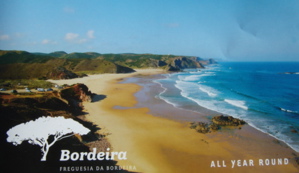
The beaches are wide and empty, between rocky stretches covered inland with a profusion of wild flowers. If you are a nature lover it is a wonderful place to visit any time from february up till mid summer.
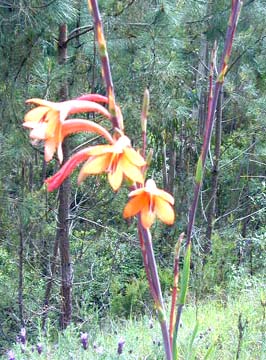
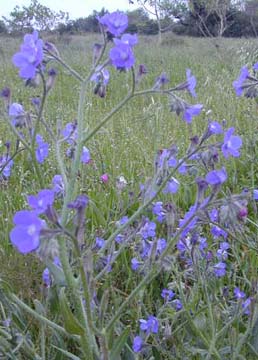
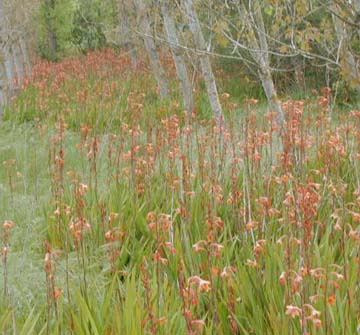
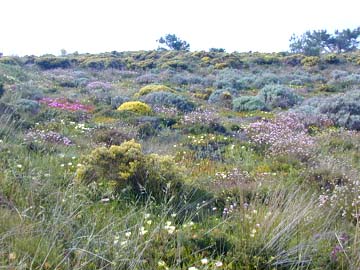
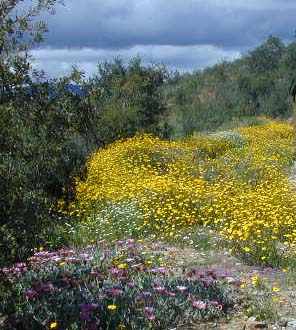
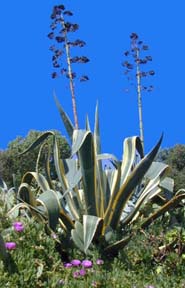
There are also a few lagoons. One in particular I rather like which is about a metre deep and you can laze in it as if it were a massive bath. That is to the south, on the road to Sagres, at Carrapateira.
As you can imagine the main concerns here are with farming, both the sea and the land, thus we get those twin local specialities, the barnacle and the sweet potato.
The festival was held in a large covered marquee in the eastern part of the village. At the approaches were a couple of stands, one selling hot chestnuts, the other selling that evil smelling barbecued octopus that the Portuguese so love. So it's quickly on past that and into the tent.
There were a couple of stalls selling sweets; chocolate cake, honey cake, and those odd little packages of nun's sweets so beloved in Iberia.
One of the most fiddly of these is the Dom Rodrigo. Basically it is made from egg yolks and almonds cooked inside a light sugar syrup, and covered with "fios de ovos" or egg filaments.
You start with finely ground almonds, both sweet and bitter mixed together, which are then almost caramelised. Eggs yolks are then added and the whole is cooked until it all becomes a nice soft cream. You then cook some sugar and water to make a syrup. You roll each cream ball in this syrup, then gently place it on a square of waxed paper to rest, and sprinkle with icing sugar and ground cinnamon.
You should now fold silver foil to make a package, usually pyramid shaped, to hold this delicate sweet, or you could wrap it like a sweet with bows on each side.
This recipe comes courtesy of the website devoted to recipes from the Algarve's two-starred Michelin restaurant, Vila Joya. If you want to try it here are the suggested ingredients: "to make 16: 240 g "fios de ovos"; 100 g sugar; 60 g ground almond; 10 egg yolks; syrup; icing sugar and ground cinnamon; waxed paper; foil; inspiration..."
It also suggests drinking a bitter almond liquor with them. Oh well, try it for Christmas.
The interesting bit is making the egg filaments. The method is to separate the yolk from the white and drop the yolk into a pan of boiling oil. You should use a clear tasteless oil. (At least, I am assuming it is oil, not boiling water, I will ask around.) You mix the egg yolks together and then pour the mixture into the pan and rake it about with a fork to break the mixture into threads. You watch for a minute or so until it is cooked, and you then use a slotted spoon to catch the threads which you immediately dunk into a bowl of cold water.
There are a couple of links here to some lousy movies showing someone making them. There is a lot of background chatter which makes it impossible for me to pick out the instructions. I like the three spouted pot they use in the second movie.
http://www.youtube.com/watch?v=H0KDbCqVO2c
http://www.youtube.com/watch?v=P5gHpdn38zI
There are masses of sweets made from almonds, honey, figs, and alforaba beans.
Star shaped sweets are made by embedding almonds around a flattened dried fig. A pasteis de nata is a custard tart over which you sprinkle cinnamon, or canela as it is called locally.
We are getting rather a lot of chocolate cakes these days, but the more traditional chocolate cake was made from ground alforaba beans.
Many of us have ancient alforaba trees in our gardens. I have two on the hill behind the house. Every summer they drop large pods like thick black runner beans. These can be collected, dried and ground into a flour which is then used as a chocolate substitute specifically to make cakes.
The trouble is, like so many things out here, the market value of the product is so low it is not worth one's while picking the fruit commercially. Oranges are everywhere. You simply cant give them away. Almonds are a little more expensive, but figs are everywhere, and there are trees along many of the roads that just drop their fruit and no-one bothers to harvest it.
Some folks collect their alforaba beans and sell sacks of them to a cooperative, but generally the pigs eat them.
Here, under the marquee in Aljezur we have sweets everywhere for sale. There are stands selling different types of honey, and strange liquours based on herbs and alforaba beans. There is even a crepes bar selling crepes filled with local jams.
One stall run by a German couple has some wonderful items made from the local olive wood. There are tables with highly polished surfaces attached to a cork stump as a central support. There is a wonderful garden seat. There are spoons and spatulas. Maybe next year I will buy some of these items, but at the moment I am supposed to be down-sizing, so I resist, but the wood is spectacular with its light colouring interspersed with dark black streaks and swirls.
On another aisle is a white-haired old lady crocheting. She is selling some amazing needlepoint. Julie carefully looks at the lace. It is perfect. We should be buying some, but what can we do with these beautiful items?
Beyond this tent is another devoted to grub. There are half a dozen restaurants all selling local food. There is one restaurant only selling game. There are quail, partridges, venison, duck, all served with sweet potato of course. Unfortunately the sweet potato is simply boiled and is rather boring. I feel it should be sauteed to go with the game, and it would be nice if we had a sauce to go with it, but this is rural Portugal and we dont get sauces.
Another restaurant is serving fish. There is bream and bass, and percebes of course and mussels, with some onion and coriander salad to go with it.
One of the restaurants has set up candles in gourds, and sausages are sizzling on small metal containers with hot coals underneath. It is all rather nice.
The whole place reminds me of the traditional Spanish sunday lunches we used to enjoy all those years ago. There is something nice about sitting down at large tables among one's neighbours, and eating a long and involved sunday lunch, and hearing the arguments, the laughter, and the general hubbub of an assorted camaraderie of folk.
Afterwards I bought my obligatory five kilo bag of sweet potatoes, plus a selection of doces (sweets), and we dodged the puddles back to the car and drove home.